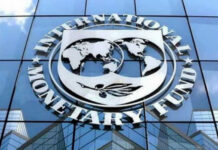Sadeq Khan
A new phenomenon has been injected in the tottering physique of the world financial order. It is the Fortaleza declaration of institutionalisation of South-South development banking and trade prospects by setting up Brics Bank. Leaders of Brazil, Russia, India, China and South Africa inked a deal, on 15 July in Fortaleza, Brazil, to launch a development bank with an initial $50 billion paid-up capital and a $100 billion monetary reserve.
The bank and the fund aim “to mobilize resources for infrastructure and sustainable development projects in BRICS and other emerging and developing economies”, and are intended to serve as an alternative to the Western-dominated World Bank and International Monetary Fund (IMF). The New Development Bank (NDB) would be headquartered in Shanghai and its initial subscribed capital will be equally shared among founding members, according to the Fortaleza Declaration.
The first chair of the Board of Governors will be from Russia, the first chair of the Board of Directors from Brazil, and the first president of the bank from India.
BRICK bank and China
The establishment of the BRICS Development Bank and the contingency reserve arrangement (CRA) is being seen as a fruition of a multilateral financial diplomacy advocated by China. With the help of the multilateral mechanism and platform, China will have more say in the world, without being cramped by Western pressure and dollar power. In response to international financial turmoil, market induced or manipulated by dollar power, the NDB will use the RMB for trade and investment in BRICS. China thus expects NDB to help promote internationalization of the RMB.
In the long term, the NDB is intended to help rebuild the international financial order and break the major Western powers’ monopoly of the international financial system. The mechanism of joint development will be open to more developing economies, and form an emerging force.
In terms of economic function, the NDB will provide long-term development aid to developing countries. The monetary reserve will provide an economic stability fund to help BRICS countries respond to financial emergencies. BRICS Development Bank and the CRA will help emerging nations to borrow cash for building highways, power stations and other major infrastructure projects, and to better cope with the risks created by international capital flows and the impact of financial turmoil.
Ahead of the BRICS summit in Brazil, at a press conference during his visit to Beijing on July 8, World Bank President Jim Yong Kim regarded the NDB as a new force for battling poverty and sharing prosperity globally: “The need for new investment in infrastructure is massive. We think we can work very well in cooperation with the new banks once they become a reality.” He added that the establishment of the NDB, catering to the need for infrastructure investment in developing countries, is welcomed by the World Bank.
A boost to world development
The World Bank provided $60 billion last year for developing nations worldwide. When combined with infrastructure investment from private sectors, the total added up to around $150, far short of real demand. One could thus look upon BRICS Bank or NDB as a junior complement of IDB, i.e. the World Bank. But the monetary principle followed by NDB may pose more of a challenge to IDB in practical terms. The NDB still needs approval from each BRICS countries’ lawmakers, which could take years. But when it is finally set up, the bank will provide an alternative source of financing for the BRICS and other emerging markets and give them much greater control over funding decisions that affect them directly.
As Russian President Vladimir Putin said: “There will be a very powerful means to prevent new economic difficulties in the world scenario and creating the bank will also establish the basis for huge macroeconomic changes.” The bank “will allow us to undertake joint plans regarding our development.”
The BRICS now account for about 20% of the world’s gross domestic product, Mr. Putin said. As their economies have grown, and taken on more importance in global trade, the BRICS and other emerging-market countries have clamoured for a bigger say in global economic decisions.
The BRICS and other emerging-market countries have vast needs for financing of infrastructure projects, according to the chief executive of Brazilian development bank BNDES, who estimated the need for long-term project finance at about $800 billion.
NDB will start out with capital of $50 billion, to be paid in equally by all five BRICS countries. Capital is planned to grow eventually to $100 billion, according to the memorandum released after the meeting in Brazil of the heads of government of the five countries.
Process of change initiated
The BRICS have been trying for years to reform the International Monetary Fund and the World Bank, the backbone of the world’s global financial structure, to give emerging markets more influence over those institutions, but with little success. In consequence, as Mark Weisbrof of Washington Centre for Economic and Policy Research observed:
“In the IMF and the World Bank, the U.S. and a handful of allies really do make almost all the decisions, and the vast majority of the world…doesn’t really have a voice. The fund has lost most of its influence on the middle-income countries in the last 15 years. This is part of the process of change in these international institutions.” And as Indian analyst M.K. Venu observes:
“The truly groundbreaking achievement in the formal launch of the BRICS Bank with a $100 billion corpus is not that five emerging economies have finally managed to create an alternative to the West-centric World Bank. The real achievement is that the structure of governance for the BRICS Bank is based on the principle of one country, one vote. The West never followed such equitable structure of governance in institutions like the World Bank and IMF, The United States has much greater clout, even veto power in these agencies. In the BRICS bank, a small economy like South Africa will have the same voting right as that of China in BRICS bank.
China and other BRICS countries have thus signalled a future cooperative framework based on the equity principle. This principle therefore might even be extended to the $100 billion Contingency Reserve Fund proposed by BRICS, which is to be tapped in times of sudden capital flight and attack on the currency of any of the BRICS countries.
So the BRICS Bank will essentially play the role that the World Bank has: funding long term physical and social infrastructure projects in emerging economies. The Reserve Fund will be more like the IMF which helps countries mitigate short term currency crises.
Say in cyber governance next
The western governments had been underestimating the determination of BRICS nations to do things their own way. The thought process to create alternative institutions and ways of working was set in motion from the very first BRICS summit in Yekaterinburg, Russia in 2009. Later, the summits in Sanya and New Delhi had firmed up ideas around how BRICS economies should move away from dollar denominated trade for goods and services exchanged among themselves. India responded by allowing Indian corporate with big infrastructure import requirement from China to “borrow in Yuan (not dollars) to fund such imports.”
India takes credit for democratisation of the global multilateral funding system as a core objective of the BRICS. New BRICS Bank and the Contingency Reserve are efforts in that direction. Prime Minister Narendra Modi of India acknowledged his predecessor’s contribution to the process, saying: “The proposal of new development bank at the summit two years ago has already been constituted into reality. We also support other developing nations (through the bank). It will be rooted in our own explanation of developing countries.”
On behalf of India, Prime Minister Narendra Modi also flagged another big issue which BRICS leaders are seriously deliberating upon: how to democratise the Cyber governance space, the current structure being again very US centric. This had assumed urgency after the Snowden revelations which clearly showed the power of Cyber hegemony in the way American authorities wilfully tapped top government offices and functionaries everywhere in the world. Narendra Modi’s visit to Brazil was preceded by express Indian official vexation over reports that US agencies were tapping the BJP leaders at will.
“Modi”-fied India has thus decidedly leaned towards an alternative, if non-polar, order pitted against dollar power and US-led globalisation. Bangladesh is a beneficiary of the US-led globalisation process, albeit fighting its way as an LDC (least developed country) in WTO rounds, but essentially by the sweat and strength of its manpower resource. Its oligarchs, mainly products of crony capitalism on the other hand, have brutally exploited manpower as well as scarce land resources of the country grabbed by muscle power. The resultant power elite in the country is inclined to indulge not only in rampant criminality and corruption at home but also ridiculous confrontation with dollar power at its own peril. Will it have a guardian-angel in NDB to come to its rescue? Doubtful, since NDB too wants a clean and competitive, and less manipulative world financial order.
Source: weekly Holiday









